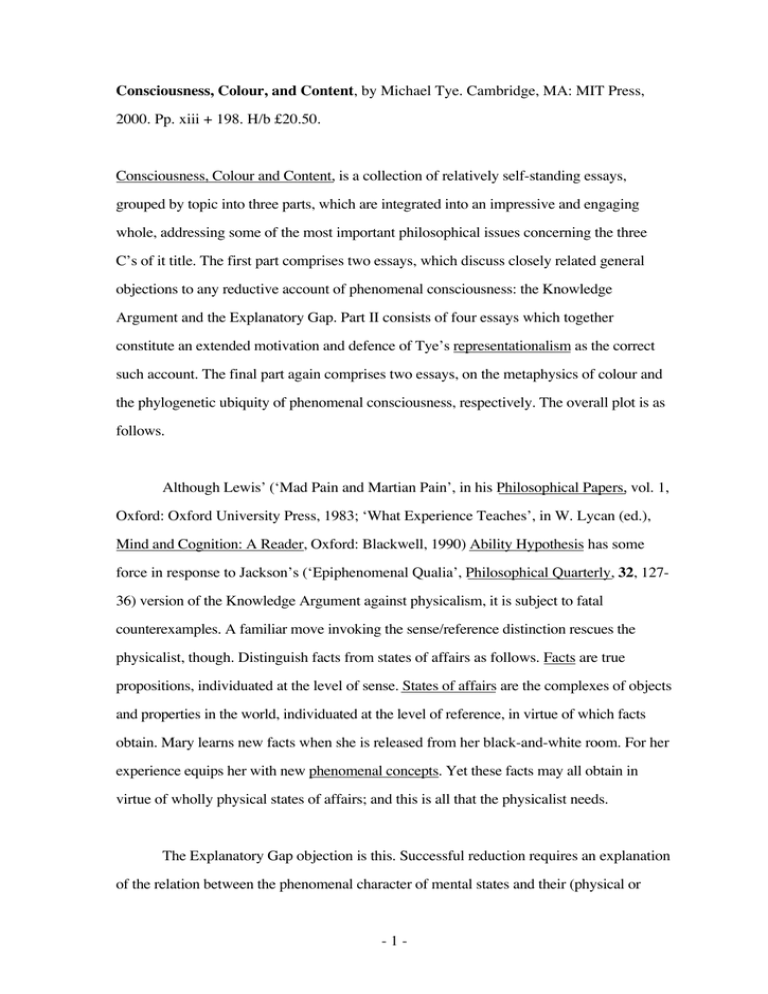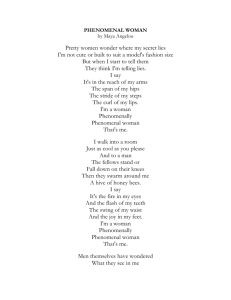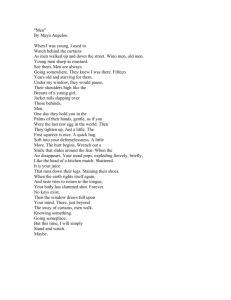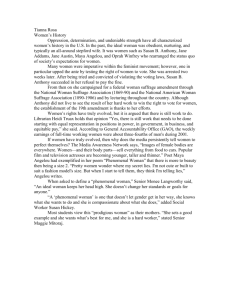2000. Pp. xiii + 198. H/b £20.50. Consciousness, Colour, and Content
advertisement

Consciousness, Colour, and Content, by Michael Tye. Cambridge, MA: MIT Press, 2000. Pp. xiii + 198. H/b £20.50. Consciousness, Colour and Content, is a collection of relatively self-standing essays, grouped by topic into three parts, which are integrated into an impressive and engaging whole, addressing some of the most important philosophical issues concerning the three C’s of it title. The first part comprises two essays, which discuss closely related general objections to any reductive account of phenomenal consciousness: the Knowledge Argument and the Explanatory Gap. Part II consists of four essays which together constitute an extended motivation and defence of Tye’s representationalism as the correct such account. The final part again comprises two essays, on the metaphysics of colour and the phylogenetic ubiquity of phenomenal consciousness, respectively. The overall plot is as follows. Although Lewis’ (‘Mad Pain and Martian Pain’, in his Philosophical Papers, vol. 1, Oxford: Oxford University Press, 1983; ‘What Experience Teaches’, in W. Lycan (ed.), Mind and Cognition: A Reader, Oxford: Blackwell, 1990) Ability Hypothesis has some force in response to Jackson’s (‘Epiphenomenal Qualia’, Philosophical Quarterly, 32, 12736) version of the Knowledge Argument against physicalism, it is subject to fatal counterexamples. A familiar move invoking the sense/reference distinction rescues the physicalist, though. Distinguish facts from states of affairs as follows. Facts are true propositions, individuated at the level of sense. States of affairs are the complexes of objects and properties in the world, individuated at the level of reference, in virtue of which facts obtain. Mary learns new facts when she is released from her black-and-white room. For her experience equips her with new phenomenal concepts. Yet these facts may all obtain in virtue of wholly physical states of affairs; and this is all that the physicalist needs. The Explanatory Gap objection is this. Successful reduction requires an explanation of the relation between the phenomenal character of mental states and their (physical or -1- functional) reductive base; but it is difficult to see how such explanation could ever be given. So reduction is extremely unlikely, at best. Given the conceptual irreducibility of the phenomenal concepts, only in terms of which phenomenal character may be expressed, though, it turns out that the specific question to which the missing explanation is sought as an answer cannot possibly be answered. So the claim that there is an answer, which the reductionist ought to be able to, but cannot (even conceivably), provide, is a cognitive illusion; and the objection fails. Tye’s central positive proposal is that “phenomenal character is one and the same as Poised, Abstract, Nonconceptual, Intentional Content” (p. 63) (PANIC). The basic representationalist idea that phenomenal character is representational content is motivated by (a) transparency: the fact that the qualities in terms of which we characterize what it is like to have various experiences are the qualities of the things in the world which such experiences present to us; and (b) intensionality: if X looks F to S, then it may not look G to S even though F and G are co-extensive (or even physically necessarily co-extensive); it will look H to S, though, if F and H are one and the same property, so metaphysically necessarily coextensive. For the representationalist idea best explains these phenomena. The representational content which captures phenomenal character in this way is, in Tye’s view, sustained by the causal correlations which would obtain were optimal or normal conditions operative. This PANIC account is developed and defended in the context of (a) various actual perceptual oddities which appear to be counterexamples; (b) Shoemaker’s (‘Phenomenal Character’, Nous, 28, 21-38; ‘Phenomenal character Revisited’, Philosophy and Phenomenological Research, 60, 465-7) ‘moderate representationalism’; and (c) a dilemma raised by Block’s (‘Inverted Earth’, in J. Tomberlin (ed.), Philosophical Perspectives, 4, Northridge, CA: Ridgeview, 1990; ‘Mental Paint and Mental Latex’, in E. Villenueva, Philosophical Issues, 7, Northridge, CA: Ridgeview, 1996) Inverted Earth together with Davidson’s (‘Representation and Interpretation’, in M. Said et al (eds.), Modelling the Mind, Oxford: Oxford University Press, 1990) Swampman. -2- It is often thought that modern science establishes conclusively that the commonsense conception of colours as mind-independent, illumination-independent properties of macroscopic physical things is mistaken. Tye considers and rejects two arguments for this view, and defends a specific reductive physicalist account of colour properties which is prima facie compatible with common sense. Finally, he deploys his PANIC account to make some provisional progress with the question where on the phylogenetic scale consciousness ceases. There is good reason to believe that it extends beyond vertebrates, to some insects such as honey bees; and there is no good reason to believe that further empirical investigation will fail to settle the matter more precisely. There is obviously a massive amount to discuss here, which is testament to the interest and range of Tye’s work. I cannot possibly take up every issue. I confine myself to two main topics: Tye’s discussion of the Explanatory Gap; and his response to the dilemma for externalist representationalism from ‘Swampman meets Inverted Earth’. 1. Tye identifies the ‘gap’ question as: “Why does physical state P feel like this [F]?” (p. 32). The objection to reduction is that there is no way of making it intelligible how the physical concept expressed by ‘P’ could possibly pick out the same thing as the phenomenal concept expressed by ‘F’. In one sense, he claims, this is false. For cogent empirical reasons may be given to believe that the concepts do have the same reference: “this feeling is physical (for how else are we to account for its causal efficacy with respect to behaviour, given the very plausible empirical hypothesis that there are no non-physical causes of the physical?) and among the physical states, …[P] is the best candidate for identification with this feeling, all things considered” (pp. 33-4). In another sense, what is being demanded here is a demonstration of the identity, from a priori truths about the phenomenal feel F, along with the physical-functional facts about P: F is physicallyfunctionally φ; P is what actually plays this physical-functional role; so F is P (on the model: water is the liquid filling lakes and oceans, coming out of taps and falling from the sky, etc; H2 O is what actually fits this description; so water is H2 O). But phenomenal -3- concepts, which pick out experiential states purely on the basis of their introspectible character, like that expressed by ‘F’ above, are conceptually irreducible. There are no a priori truths of the form ‘F is the φ’, to provide the first premise of such a demonstration. For phenomenal concepts are directly recognitional, and do not reach out to their referent via any associated description. Hence it is conceptually guaranteed that this latter demand cannot be met. So there is no gap, which the reductionist ought to be able to, but cannot, fill. The lack of this kind of demonstration is a consequence of the nature of phenomenal concepts, rather than any objection to satisfactory reduction. This is a strange response. First, the irreducibility of phenomenal concepts is effectively equivalent to a certain unintelligibility in any physical reduction of the experiences to which they apply. The Gap objection is that it is mysterious how phenomenal ‘F’ and physical ‘P’ could pick out one and the same condition of a person. Tye’s reply is that this mystery is conceptually guaranteed by the nature of phenomenal concepts, which identify their referents in such a way as to give no clue as to how these might be any specific physical thing. So the reductionist’s failure to come up with a clue is no real failure. A proposed reduction does in general incur an obligation, though, at least to extract from reflection upon the condition to be reduced sufficient conditions to make the identification of the reducing condition non-arbitrary. If phenomenal concepts really were such as to guarantee that this obligation cannot be met, then surely so much the worse for any proposed reduction. Second, Tye himself suggests a way of meeting the obligation, in insisting that ‘empirical reasons’ may be given in defence of a specific such reduction. For these reasons must initially be aimed at the right phenomenon by reflection upon F itself. (The exclusive contrast between ‘empirical reasons’ and ‘a priori demonstration’ is misleading: both have a priori and empirical elements.) In the light of his representationalism, this might go as follows. What is definitive of phenomenal character F is its transparent presentation of the colour property C - redness, say - of macroscopic things in the world (a property which cannot be identified as C without such experience of it, which explains the perspectival subjectivity of ‘F’). Detailed psychological investigation -4- points to neural activity P as what is crucial to the detection of C by normal subjects in normal lighting conditions. So P is the physical basis of F. None of this is straightforward, and there are important issues concerning the precise interpretation of the conclusion (is it a property identity/reduction, or merely the identification of a neural enabling condition for Ftype experiences?). Still, it provides an illustration of the kind of explanation which Tye’s account of phenomenal concepts is supposed to exclude. 2. The positive theory of phenomenal consciousness on offer is PANIC, an externalist version of representationalism: the phenomenal character of an experiential state S is its poised, abstract, nonconceptual intentional content, where intentional content is determined by certain causal correlations between S and features of the subject’s environment. Now, suppose that I am fitted with colour inverting lenses whilst asleep, and transported unawares to Inverted Earth (IE), where the colours of things are themselves inverted (the sky is yellow, grass is red, etc). When I wake up, the sky still looks blue to me, grass green, and so on, since the lenses compensate for the colour inversion. This continues to be so throughout my time on IE. Given an externalist account of intentional content, though, I will eventually adjust sufficiently to my new environment that the state normally produced in me by the sky will represent it as yellow rather than blue. So phenomenal character remains fixed, whilst PANIC varies. Attempting to save Tye’s theory by insisting that the external correlations determinative of content are teleological - those which the state evolved to secure - succeeds in keeping PANIC constant in this case, in line with constancy of phenomenal character. It has the implausible consequence, though, that an accidental molecule-for-molecule replica of a sentient creature has no intentional content, and hence no phenomenal experience. Thus, IE and Swampman together present a dilemma for PANIC, dividing over the question whether the tracking determinative of content is teleological. (A mixed account cannot handle a Swampman who undergoes the same intervention-plus-transportation as I do.) An initial response is to bite the bullet: externalism implies that conceptual thought content adjusts to the new IE environment; nonconceptual sensory content does so too. So -5- phenomenal character eventually alters in such a way that the sky comes to look yellow to me. Tye recognizes that this line has some plausibility. In the end, though, he dismisses it on the grounds that the purported phenomenal transformation over time adjusting to IE is unintelligible: if it is supposed gradual, it is arbitrary which way around the hue circle it goes; if it is supposed sudden, it is arbitrary precisely when it occurs. His own response is to claim that the causal correlations determinative of the nonconceptual content of basic sensory states are those which would obtain were conditions optimal. However long I stay on IE, then, my experiences represent the sky as blue. For the inverting lenses are a permanent interference with optimal conditions. This handles standard Swampman, whose conditions are optimal; and travelling Swampman is just like me: we both face a lasting nonoptimal intervention. In both IE cases, conceptual representation adjusts over time to the new environment; but nonconceptual content and phenomenal character remain unchanged. An obvious worry about Tye’s ‘softer’ response concerns the relation between nonconceptual and conceptual content. After my adjustment on IE, my experience of the sky supposedly continues representing this illusorily as blue. Yet my thoughts expressed using the word ‘blue’ have changed in content, now referring to yellow. Presumably, I agree with my new friends in assenting to ‘the sky is blue’. Yet, exploiting the demonstrative ‘that[SKY] colour’ to pick up the representational content of my experience whilst looking up at the sky, perception inclines me to endorse the contradictory thought ‘the sky is that[SKY] colour’. If I do so, then I am equally stuck with a whole set of similar contradictions - ‘that scarf is blue; it is that[SCARF] colour’, and so on - which surely undermines the idea that I really do understand what I am thinking when I supposedly mean yellow by ‘blue’. If, on the other hand, I do not endorse the thought ‘the sky is that[SKY] colour’, then Tye must explain why not, and when and how I cease doing so. Neither option strikes me as tenable. The only alternative is to break the connection between ‘that[SKY] colour’ and the nonconceptual content of my experience whilst looking up at the sky, by insisting that, although the latter remains constant throughout my visit to IE, the former changes its reference gradually from blue to yellow along with ‘blue’ itself. This contradicts the claim that experiential content is -6- poised for anything, though, if it does not even determine the corresponding perceptual demonstrative content. In any case, given Tye’s view that my experience represents the sky to me as being a determinate colour - blue - the objection can simply be reformulated in terms of new demonstrative ‘pthat[SKY] colour’ which is stipulated to mirror this experiential content. Tye’s solution to the initial dilemma faces a further difficulty. His key idea is that inverting lenses constitute a permanent interference with optimal conditions. So, however long I remain on IE, the perceptual state which is caused in me by looking at the yellow sky is one which would have been causally correlated with blue things in optimal conditions (without the lenses). Now consider a case closer to home, on which we actually have robust data (J. G. Taylor, The Behavioural Basis of Perception, New Haven, CN: Yale University Press, 1962). If I remain on earth, where I am fitted with left-right reversing lenses, then, initially, what is to my left appears to be to my right, and vice versa; but I eventually adjust, and sensory appearances are restored to veridicality. Yet things to my left still produce in me the physical effects which used to be correlated with things to my right. So, if Tye is right to regard the insertion of the lenses as a permanent interference with optimal conditions, then his account entails that the state produced in me by things to my left continues representing those things as to my right. This is not so. Hence, either Tye’s ‘optimal counterfactual’ account of sensory representation is mistaken, or he is wrong to regard lens insertion as a permanent interference with optimal conditions. Either way, his response to the dilemma is in trouble. In fact, this brief reflection on the effects of reversing lenses on earth suggests a reply to Tye’s objection to the bullet-biting response. The key idea here is that what goes for thought content goes for sensory content, and hence phenomenal character, too. Thus, as I adjust to my new environment on IE, all change so as to represent colours correctly. This idea receives preliminary support from the problems just sketched for Tye’s own attempt to treat conceptual and sensory content differently. He is moved to this ‘softer’ response by -7- the claim that any gradual colour inversion in sensory content as I adjust to IE, of the kind which is proposed by the bullet-biting response, is unintelligible. Keeping firmly in mind the idea that sensory content, and thus phenomenal character, are determined by the actual worldly properties which are detected and discriminated by the subject, though, the following picture of the phenomenology is surely quite plausible. Immediately on arrival on IE, the sky looks blue, grass green, and so on. As I interact with my new environment and the people I meet there, these colours begin seep out, as if someone had turned down the colour on the TV. In my state of most confusion, and least successful detection and discrimination, all is black, white, and shades of grey for me all I am capable of tracking are differences in brightness. Eventually the colour returns, now inverted in line with the actual colours of the things around me, until the sky looks clearly yellow, grass red and so on. I myself have no difficulty envisaging this course of events. Furthermore, there is evidence that colour adaptation is indeed possible to the use to distorting goggles on earth (I. Kohler, ‘Experiments with Goggles’, Scientific American, 206, 62-86). So Tye’s accusation of unintelligibility is on weak ground empirically. And if such adaptation could be achieved to full colour inverting lenses, then the phenomenal adjustment on IE would presumably be precisely the reverse. In spite of my reservations concerning these two major issues, though, and a number of others besides, this is, without doubt, a strong and interesting book, presenting a series of clear arguments for some novel proposals on important issues. St. Catherine’s College BILL BREWER Oxford, OX1 3UJ England -8-


